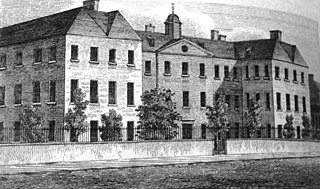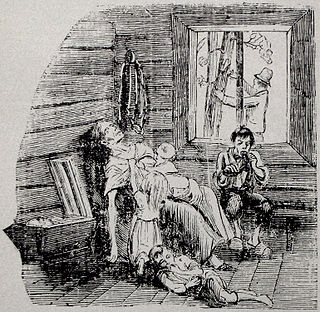
Spandau Prison was located in the borough of Spandau in western Berlin. It was constructed in 1876 and demolished in August 1987 after the death of its last prisoner, Rudolf Hess who had died from a suspected suicide aged 93, to prevent it from becoming a neo-Nazi shrine. The site was later rebuilt as a shopping centre for the British forces stationed in Germany.

The English Poor Laws were a system of poor relief which existed in England and Wales that developed out of late-medieval and Tudor-era laws being codified in 1587–98. The Poor Law system was in existence until the emergence of the modern welfare state after the Second World War.

Bethlem Royal Hospital, also known as St Mary Bethlehem, Bethlehem Hospital and Bedlam, is a psychiatric hospital in London. Its famous history has inspired several horror books, films and TV series, most notably Bedlam, a 1946 film with Boris Karloff.

In England and Wales, a workhouse, colloquially known as a spike, was a place where those unable to support themselves were offered accommodation and employment. The earliest known use of the term workhouse is from 1631, in an account by the mayor of Abingdon reporting that "wee haue erected wthn our borough a workehouse to sett poore people to worke".
The Abraham-men were a class of beggars claiming to be lunatics allowed out of restraint, in the Tudor and Stuart periods in England.

California Institution for Men (CIM) is a male-only state prison located in the city of Chino, San Bernardino County, California. It is often colloquially referenced as "Chino". In turn, locals call the prison "Chino Men's" or just "Men's" to avoid confusion with the city itself.

The Andover workhouse scandal of the mid-1840s exposed serious defects in the administration of the English 'New Poor Law' and led to significant changes in its central supervision and increased parliamentary scrutiny. The scandal began with the revelation in August 1845 that inmates of the workhouse in Andover, Hampshire, England were driven by hunger to eat the marrow and gristle off bones which they were supposed to crush to make fertilizer. The inmates' rations set by the local Poor Law guardians were less than the subsistence diet decreed by the central Poor Law Commission (PLC), and the master of the workhouse was diverting some of the rations for private gain. The guardians were lothe to lose the services of the master, despite this, and despite allegations of the master's drunkenness on duty and sexual abuse of female inmates. The commission had the power to order dismissal of the master, but only did so after ordering two attempts by an assistant-commissioner to hold an inquiry into the charges; the conduct of the inquiry drew criticism.

The Poor Relief Act 1601 was an Act of the Parliament of England. The Act for the Relief of the Poor 1601, popularly known as the Elizabethan Poor Law, "43rd Elizabeth" or the Old Poor Law was passed in 1601 and created a poor law system for England and Wales.

Blessed Marie Louise Trichet, also known as Marie-Louise de Jésus (1684–1759), was a French Catholic figure who, with Saint Louis de Montfort, founded the Congregation of religious women called Daughters of Wisdom and since the age of seventeen devoted her life to caring for the poor and the sick. She is also referred to as the First Daughter of Wisdom. She was beatified by Pope John Paul II.

Claude-Nicolas Perier was assured an important place in French history when he opened his Château de Vizille near Grenoble to the famous meeting of the estates of the Province of Dauphiné heralding the coming of the French Revolution. He is notable also as the founder of the remarkable Perier family "bourgeois dynasty" that rose to economic and political influence and prominence in France during the 19th century. Claude's descendents became leading Paris bankers, regents of the Bank of France and owner-directors of Anzin, the major coal mining company of France in the Department of Nord. They were mayors of towns, prefects of departments and members of municipal tribunals and chambers of commerce. Many were elected representatives of departments to the Chamber of Deputies in Paris and appointed to France's Chamber of Peers. Most notably, Casimir Pierre Perier (1777-1832), the fourth of Claude's eight sons, became Prime Minister of France in 1831-32 during the Orleanist monarchy of Louis-Philippe I. Claude's grandson, Jean Casimir-Perier (1847-1907), was elected president of the Third Republic in 1894. Claude Perier was sufficiently wealthy before 1789 to be known as "Perier-Milord" in Grenoble and surroundings, but it was mainly during the decade of revolution 1789-99 that he created the financial underpinning of the Perier dynasty. His eight sons and two daughters would share his legacy of 5,800,000 francs.
From the mid-1700s until the 1970s, countries and individual cities had unsightly beggar ordinances known colloquially as ugly laws. These laws deemed it illegal for "any person, who is diseased, maimed, mutilated or deformed in any way, so as to be an unsightly or disgusting object, to expose himself to public view." Exceptions to public exposure were acceptable only if the people were subjects of demonstration, to illustrate the separation of disabled from nondisabled and their need for reformation.

St Peter's Hospital, Bristol could be found to the rear of St Peter's church until it was destroyed in the Bristol Blitz in 1940.
Leigh Union workhouse, also known as the Leigh workhouse and after 1930, Atherleigh Hospital, was a workhouse built in 1850 by the Leigh Poor Law Union on Leigh Road, Atherton in the historic county of Lancashire.

The Diseases Prevention (Metropolis) Act was an Act of Parliament of the United Kingdom passed in 1883, during the reign of Queen Victoria. Earlier in the century the Metropolitan Asylums Board (MAB) had been established under the Metropolitan Poor Act 1867 to deal with London's sick poor, run as a Poor Law institution. But under increasing pressure resulting from a series of smallpox epidemics in the early 1880s a Royal Commission was set up in 1881 to investigate how best to deal with those suffering from infectious diseases. The commission recommended that the provision of hospital treatment for those with infectious diseases should be decoupled from the Poor Law, and instead be considered part of London's sanitary arrangements. The commission also recommended that paupers and non-paupers should be treated alike, although there might be separate wards for those able to pay. The subsequent Disease Prevention (Metropolis) Act of 1883 effectively abolished the distinction between paupers and non-paupers in the provision of the MAB's hospital care. It also had the effect of permitting workhouse infirmaries to treat paying non-paupers as well as their own inmates, and by the beginning of the 20th century some were even able to operate as private hospitals.

The Scottish poorhouse, occasionally referred to as a workhouse, provided accommodation for the destitute and poor in Scotland. The term poorhouse was almost invariably used to describe the institutions in that country, as unlike the regime in their workhouse counterparts in neighbouring England and Wales residents were not usually required to labour in return for their upkeep.
The following is a timeline of the history of the city of Grenoble, France.
The Bedwellty Union Workhouse was situated in Georgetown, Tredegar. It is 2.9 miles (4.7 km) from the Nanybwtch Junction A465. The building was in existence for approximately 127 years. The workhouse building was also used as a hospital. Today, the site where the building once stood, there is a housing estate known as St James Park.

Brownlow Hill infirmary was a large workhouse infirmary in Liverpool, notable for its role in advancing training of nurses. The workhouse was demolished in 1931, and the site is now occupied by Liverpool's Catholic cathedral.
Workhouse infirmaries were established in the nineteenth century in England. They developed from the Workhouse and were run under the Poor law regime.

The Famine of 1867–1869 was the last famine in Sweden, and the last major naturally caused famine in Europe.



















